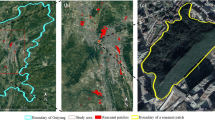Abstract
Patterns of revegetation on natural and human-caused disturbances in grasslands and savannas of the Serengeti National Park, Tanzania, were investigated by recording species compositions on all disturbances, in the undisturbed vegetation, and in unique microhabitats in 51 sites along a north-to-south transect through the park. The 487 resulting samples were ordinated by detrended correspondence analysis (DCA) and classified by two-way indicator species analysis (TWINSPAN). Natural disturbances were, in most cases, ordinated near or classified together with the climax sample from the same site but human-caused disturbances were classified separately. Human disturbances from all regions of the park were classified together in one group, while natural disturbances were divided into communities associated with different rainfall regimes. Natural disturbances were revegetated by species growing in the surrounding undisturbed communities while human-caused disturbances were revegetated by a set of ruderal species not found in the undisturbed communities nor in natural disturbances.
Similar content being viewed by others
References
Anderson, G. D. & Talbot, L. M., 1965. Soil factors affecting the distribution of the grassland types and their utilization by wild animals on the Serengeti Plains, Tanganyika. J. Ecol. 53: 33–56.
Belsky, A. J., 1983. Small-scale pattern in grassland communities in the Serengeti National Park, Tanzania. Vegetatio 55: 141–151.
Belsky, A. J., 1985. Long-term vegetation monitoring in the Serengeti National Park, Tanzania. J. Appl. Ecol. 22: 449–460.
Belsky, A. J., 1986a. Revegetation of artificial disturbances in grasslands of the Serengeti National Park, Tanzania. I. Colonization of grazed and ungrazed plots. J. Ecol. 74: 419–437.
Belsky, A. J., 1986b. Revegetation of artificial disturbances in grasslands of the Serengeti National Park, Tanzania. II. Five years of successional change. J. Ecol. 74: (in press).
Belsky, A. J., 1986c. Population and community processes in a mosaic grassland in the Serengeti, Tanzania. J. Ecol. 74: 841–856.
Belsky, A. J. & Amundson, R. G., 1986. Sixty years of successional history behind a moving sand dune near Olduvai Gorge, Tanzania. Biotropica 18: 231–235.
Bernhard-Reversat, F., 1982. Biogeochemical cycles of nitrogen in a semi-arid savanna. Oikos 38: 321–332.
Clifford, H. T., 1959. Seed dispersal by motor vehicles. J. Ecol. 47: 311–315.
Croze, J., 1974. The Seronera bull problem. II. The trees. E. Afr. Wildl. J. 12: 29–47.
De Wit, H. A., 1978. Soils and grassland types of the Serengeti Plains (Tanzania). Ph.D. Thesis. Wageningen.
Grzimek, M. & Grzimek, B., 1960. A study of the game of the Serengeti Plains. Z. Saügetierk. 25: 1–61.
Herlocker, D., 1976. Woody vegetation of the Serengeti National Park. Texas A and M University Press, College Station, TX.
Hill, M. O., 1979a. DECORANA — A FORTRAN program for detrended correspondence analysis and reciprocal averaging. Cornell Ecology Program. Ecology and Systematics, Cornell University, Ithaca.
Hill, M. O., 1979b. TWINSPAN — A FORTRAN program for arranging multivariate data in an ordered two-way table by classification of the individuals and attributes. Cornell Ecology Program. Ecology and Systematics, Cornell University, Ithaca.
Hill, M. O. & GauchJr, H. G., 1980. Detrended correspondence analysis: an improved ordination technique. Vegetatio 42: 47–58.
Ivens, G. W., 1967. East African weeds and their control. Oxford University Press, Nairobi.
Jager, T., 1982. Soils of the Serengeti Woodlands, Tanzania. Pudoc, Wageningen.
Kellman, M., 1979. Soil enrichment by neotropical savanna trees. J. Ecol. 67: 565–577.
Knoop, W. T. & Walker, B. H., 1985. Interactions of woody and herbaceous vegetation in a southern African savanna. J. Ecol. 73: 235–254.
Lamprey, H. F., Glover, P. E., Turner, M. I. M. & Bell, R. H. V., 1967. Invasion of the Serengeti National Park by elephants. E. Afr. Wildl. J. 5: 151–166.
McNaughton, S. J., 1983. Serengeti grassland ecology: the role of composite environmental factors and contigency in community organization. Ecol. Monogr. 53: 291–320.
McNaughton, S. J., 1985. Ecology of a grazing ecosystem: the Serengeti. Ecol. Monogr. 55: 259–294.
Norton-Griffiths, M., 1979. The influence of grazing, browsing and fire on the vegetation dynamics of the Serengeti. In: A. R. E.Sinclair & M.Norton-Griffiths (eds), Serengeti: Dynamics of an ecosystem, pp. 310–352. University of Chicago Press, Chicago.
Norton-Griffiths, M., Herlocker, D. & Pennycuick, L., 1975. The patterns of rainfall in the Serengeti ecosystem, Tanzania. E. Afr. Wildl. J. 13: 347–374.
Pellew, R. A. P., 1983. The impacts of elephant, giraffe and fire upon the Acacia tortilis woodlands of the Serengeti. Afr. J. Ecol. 21: 41–74.
Schmidt, W., 1975a. Plant communities in permanent plots of the Serengeti Plains. Vegetatio 30: 133–145.
Schmidt, W., 1975b. The vegetation of the northeastern Serengeti National Park, Tanzania. Phytocoenologia 3: 30–82.
Sinclair, A. R. E., 1979a. Dynamics of the Serengeti ecosystem: process and pattern. In: A. R. E.Sinclair & M.Norton-Griffiths (eds), Serengeti: Dynamics of an ecosystem, pp. 1–30. University of Chicago Press, Chicago.
Sinclair, A. R. E., 1979b. The eruption of the ruminants. In: A. R. E.Sinclair & M.Norton-Griffiths (eds), Serengeti: Dynamics of an ecosystem, pp. 82–103. University of Chicago Press, Chicago.
Sinclair, A. R. E. & Norton-Griffiths, M., (eds), 1979. Serengeti: Dynamics of an ecosystem. University of Chicago Press, Chicago.
Tiedemann, A. R. & Klemmedson, J. O., 1977. Effect of mesquite trees on vegetation and soils in the desert grasslands. J. Range Mngt. 30: 361–367.
Author information
Authors and Affiliations
Additional information
Plant nomenclature follows Clayton a.o. (1970–1982) Flora of Tropical East Africa: Gramineae Parts 1–3, Nairobi for grasses and Agnew (1974), Upland Kenya Wildflowers, London for herbs and shrubs.
This research was funded by a grant from the U.S. National Science Foundation (DEB-81-14306) and is Serengeti Research Institute Contribution #335.
Rights and permissions
About this article
Cite this article
Belsky, A.J. Revegetation of natural and human-caused disturbances in the Serengeti National Park, Tanzania. Vegetatio 70, 51–60 (1987). https://doi.org/10.1007/BF00040758
Accepted:
Issue Date:
DOI: https://doi.org/10.1007/BF00040758




